Rooftop Tents are perfect tents for camping. You're off the ground, away from the cold mud and closer to the spots you plan to visit. If you're planning a trip to Snowdonia or Lake District or any of the other beautiful camping spots in the UK and want to upgrade to a roof tent then you're in the right place.
Before getting into the list of the best rooftop tents we thought it would be helpful to explain a few fundamentals about what is a roof tent, how does one work and what makes a good rooftop tent including the pros and cons.
If you want to jump straight into the Top 10 Roof Top Tents to purchase in the United Kingdom right now then please feel free to use the links below to jump to the section of your choice!

Jump to our most popular sections
Other Roof Tent Favourites
(Click the links below to jump ahead)
Best Soft-Shell Roof Tents

TentBox Lite 2.0
Lightweight & Fast to Install
A roof tent that is lightweight, has a thick comfy mattress and space for two and a fast set up
TentBox Lite 2.0
The features and value the TentBox Lite provides are what makes it special. It's great for beginners looking for a spacious roof top tent with premium features at a reasonable price point.
Big enough to sleep 2 people with a sleeping area of 133cm x 220cm add to that a 8cm high-density foam mattress gives you all you need for a comfortable nights sleep.
It's got a great price point from one of the most reputable Roof Tent brands in the UK. The TentBox Lite 2.0 comes with quality material throughout, great water resistance, good space for two people, extended warranty and the TentBox brand is backed by thousands of reviews so its hard to go wrong for beginners, a bit different than the TentBox XL.



Great comfort with an 5cm Dual Layer mattress
The TentBox Lite 2.0 features a dual layer 5cm mattress with waterproof materials
High Quality Fabrics with great weather resistance
All materials come with C6 DWR (water-repellency), 2400mm/24hr breathability and UV50+ protection ensuring that you stay safe and protected from heavy rain or harmful UV rays while camping.
Other great features:
Fast setup - Once installed, fold open and set up 6 poles and you're done!
Removable Rainfly - If you don't need it simply take it off for an even faster setup
Strict Testing - Hydrostatic Rating tests, Wind Resistance testing to withstand 39mph winds
| Specifications | |
|---|---|
| Sleeping Capacity | 2 People |
| Setup Time | Less than 5 minutes |
| Weight | 50kg |
| Sleeping Area | 133cm (W) x 220cm (L) x 105cm (H) |
| Closed Dimension | 133cm (W) x 110cm (L) x 25cm (H) |
| Mattress | 5cm Dual Layer Foam Mattress |
| Water Resistance | 3000mm (inner pod) and 5000mm (rainfly) |
Pros
- Wind tested up to 39mph
- Lay Flat ladder steps
- Good space for two (133cm x 220cm)
- Industry leading 5 Year Warranty
- Free Delivery
Cons
- Can't leave bedding inside
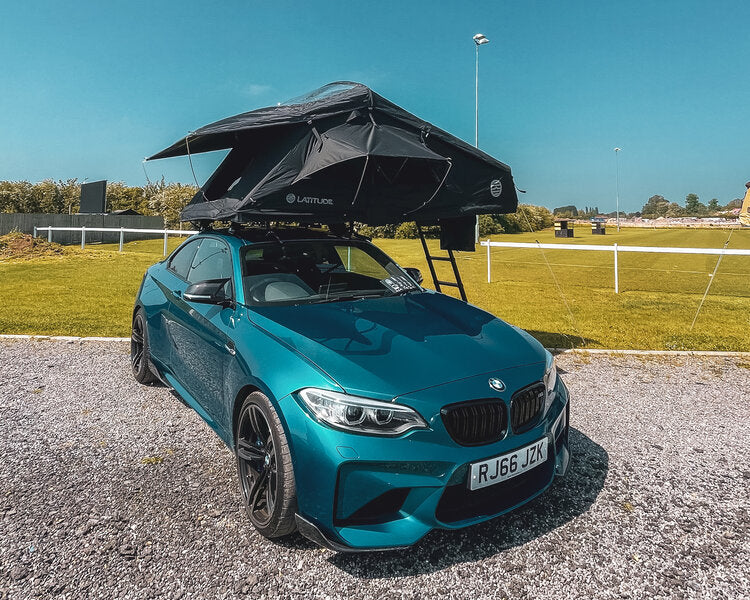
Latitude Tents Pioneer
Large sleeping space for Two
Lightweight, great space for 2 people and great comfort
The Latitude Tents Pioneer has been out for a little while but there are still few better at designing such a lightweight (54kg) rooftop tent without compromising on quality.
At this weight it is very likely that your car manufacturer will have a roof weight load (the maximum weight your car allows whilst driving) that will take on the Pioneer roof tent.
That's why we recommend this soft shell rooftop tent for those who own smaller cars (okay to go on a mini!). We still recommend you check your cars maximum weight load in the manual.
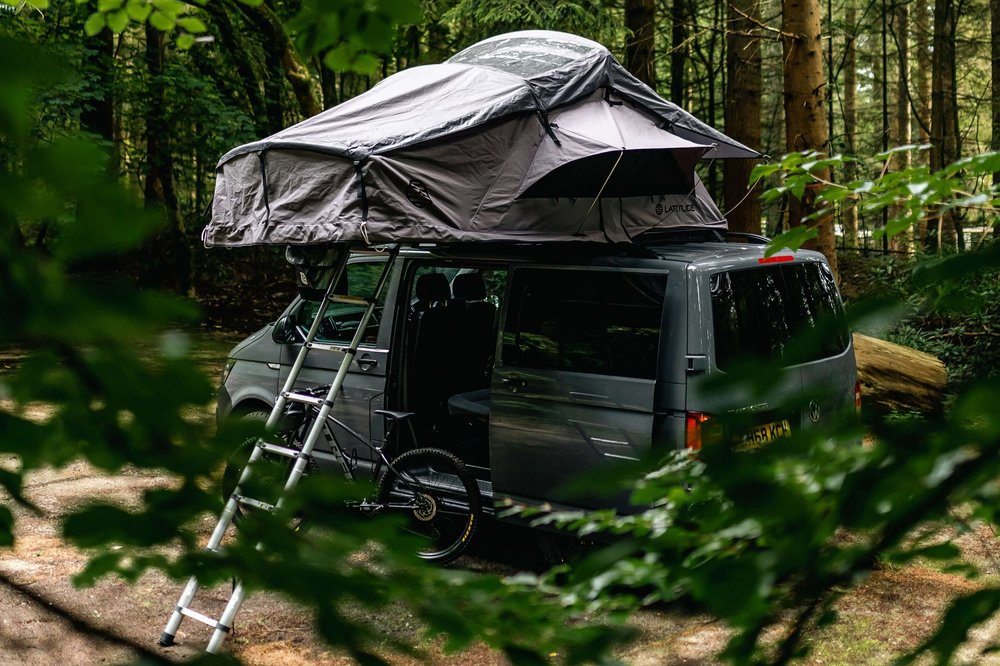


If you want a super affordable roof top tent then just get this and don't worry about anything else.
Made of high quality materials? Check. Great space for two people. Check. Simple no fuss set up time. Check. High-density foam mattress. Check. Water resistant. HH 3,000mm Check.
No need to overthink it!
What we love the most:
+ Large space for comfort - 140cm by 240cm only slightly smaller than a queen size bed (which are usually 153cm by 203cm).
+ High-quality materials - made with 280g Rip-stop Polyester Cotten and a waterproof and UV resistant coating
+ Comfortable foam mattress - 60mm thick non deforming high density foam mattress that stays in the rooftop tent when packed away
+ Travel Cover Material - 550g heavy-duty PVC cover to protect against the elements.
| Specifications | |
|---|---|
| Sleeping Capacity | 2-3 People |
| Setup Time | 5 minutes |
| Weight | 54 Kg |
| Sleeping Area | 140 x 240 cm |
| Closed Dimensions | 125 x 140 x 25 cm (LxWxH) |
| Mattress | 6cm thick Mattress |
| Water Resistance | 3000mm Hydrostatic Head Rating. |
Pros
- Comfortable foam mattress
- Large space for comfort
- High-quality material
Cons
- Set up time 5 mins
Best Hardshell Roof tent

Femkes Miles Starling
Best Hardshell Roof tent
Pop up in 60 seconds with luxurious panoramic windows for great views
Set up the Miles Starling in 60 seconds using the four gas assisted springs to open the roof tent. Just unbuckle the straps, raise the shel on each side and you're done!
That's why we recommend this hard shell rooftop tent for those who own smaller cars (okay to go on a mini!). We still recommend you check your cars maximum weight load in the manual.
Advantages of Femkes Miles Starling
Convenience: The pop-up design enables easy and quick setup, eliminating the need for complex tent assembly.
Leave bedding inside when closed: Super handy when you want to get up and go and not have to use up boot space to carry your comfy duvets & pillows.
Protection: Hardshell construction provides excellent protection against rain, wind, and other weather conditions.
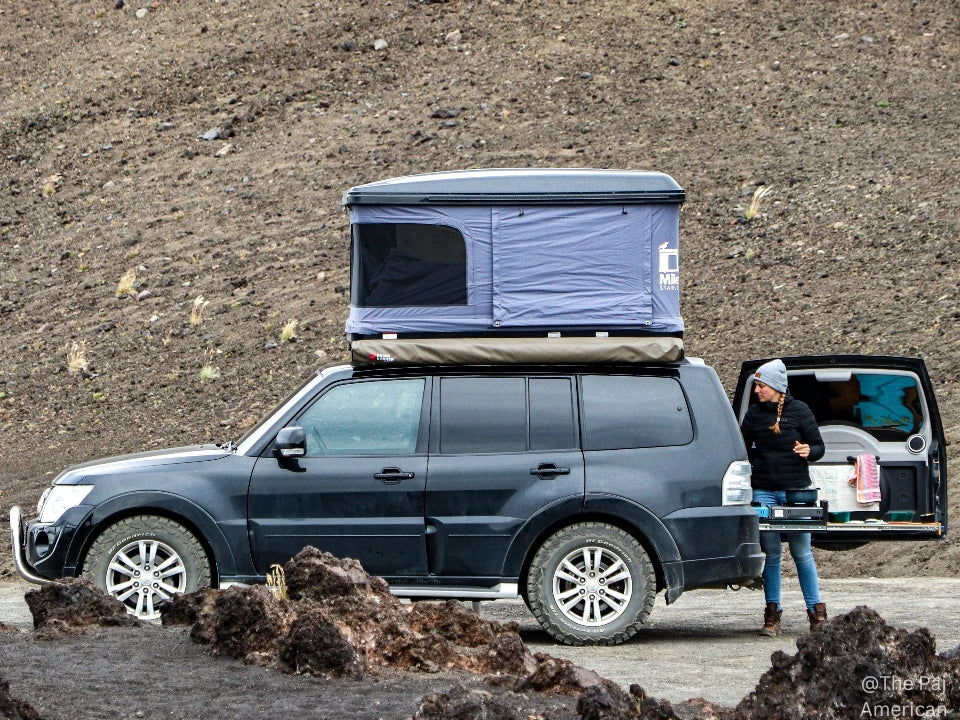


A Roof Tent with great views
The Miles Starling was designed to make sure you enjoy the amazing views you've chosen to set up camp. With almost unrestricted views all around your roof tent, fine mosquito netting and great ventilation you can appreciate the morning sun or sunset whilst you rest.
High density Mattress
Slow foam high density 6cm mattress with a removable cover and a 1cm thick ventilating anti-condensation 3D mesh bottom mattress.
| Specifications | |
|---|---|
| Sleeping Capacity | 2 People |
| Setup Time | 1 minute |
| Weight | 74kg incl Ladder |
| Sleeping Area | 206 x 136 cm |
| Closed Dimensions | 214 x 142 x 31 cm (L x W x H) |
| Mattress | Slow Foam High Density Mattress |
| Water Resistance | 3000mm Hydrostatic Head Rating. |
Pros
- 1 minute set up time
- Keep your bedding inside
- Panoramic windows for views
Cons
- Not suitable for more than 2 people
Best Four Person Roof tents

TentBox Lite XL
Lightweight & Fast to Install
At 62kg the TentBox XL is not only great in size but great super lightweight and likely to meet your weight limits
Larger than a Super King Sized Bed
Like its smaller brother the TentBox Lite XL folds out into a great space for four people to sleep in comfortably. This is ideal for a family of four or 3 adults who really like their space!
Great materials, great water proofing, double skylight and good storage from one of the UKs biggest roof tent brand. It is a safe bet.
With an internal mattress size of 183cm x 240cm (A Super King Sized Bed is typically 180cm x 200cm). So see if you can get your family to all fit on a super king sized bed and you'll have more than enough room in the TentBox XL.



Great comfort with an 5cm Dual Layer mattress
The TentBox Lite XL features a dual layer 5cm mattress with waterproof materials helping with moisture build up inside the tent.
High Quality Fabrics with great weather resistance
All materials come with C6 DWR (water-repellency), 2400mm/24hr breathability and UV50+ protection ensuring that you stay safe and protected from heavy rain or harmful UV rays while camping.
Other great features:
Fast setup - Once installed, fold open and set up 6 poles and you're done!
Removable Rainfly - If you don't need it simply take it off for an even faster setup
Strict Testing - Hydrostatic Rating tests, Wind Resistance testing to withstand 39mph winds
Award Winner - Won Best Roof Tent by Out & About
| Specifications | |
|---|---|
| Sleeping Capacity | 4 People |
| Setup Time | Less than 5 minutes |
| Weight | 62kg |
| Sleeping Area | 183cm (W) x 240cm (L) x 115cm (H) |
| Closed Dimension | 183cm (W) x 120cm (L) x 25cm (H) |
| Mattress | 5cm Dual Layer Foam Mattress |
| Water Resistance | 3000mm (inner pod) and 5000mm (rainfly) |
Pros
- Durable & lightweight at 62kg
- Lay Flat ladder steps
- Wind tested up to 39mph
- Industry Leading 5 Year Warranty
- Free Delivery
Cons
- Can't leave bedding inside
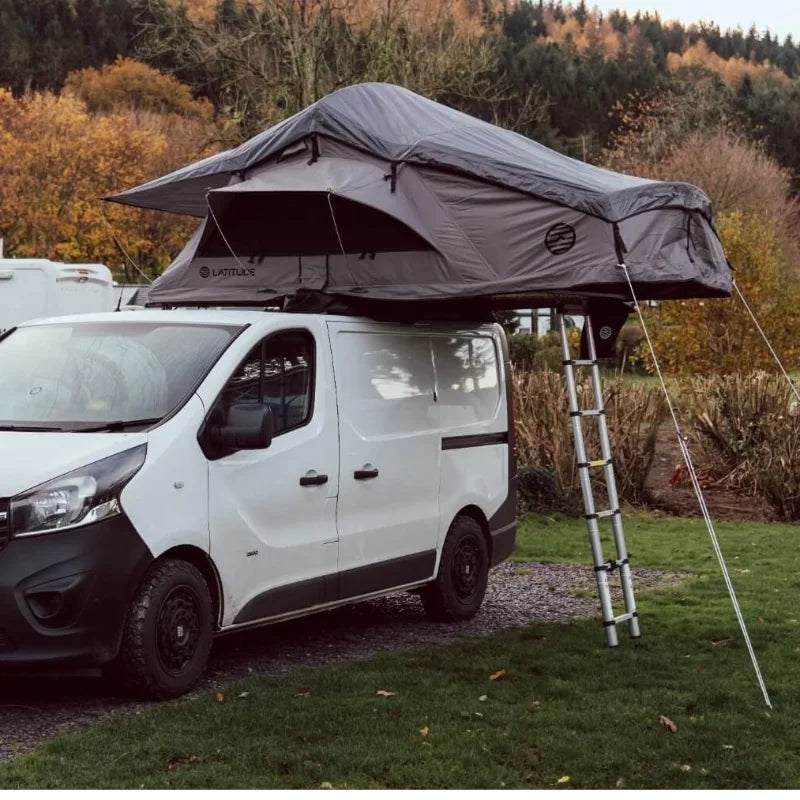
Latitude Tents Pioneer XL
Largest Roof tent
Lightweight, great space for 2 people and great comfort
Bigger than a Super King-sized bed for a Family
The internal mattress measures in at 190cm x 240cm!
For comparison a Super King Sized Bed is 180cm x 200cm so you should have no problems fitting your family in
Comfortable foam mattress
60mm thick non deforming high density foam mattress that stays in the rooftop tent when packed always.

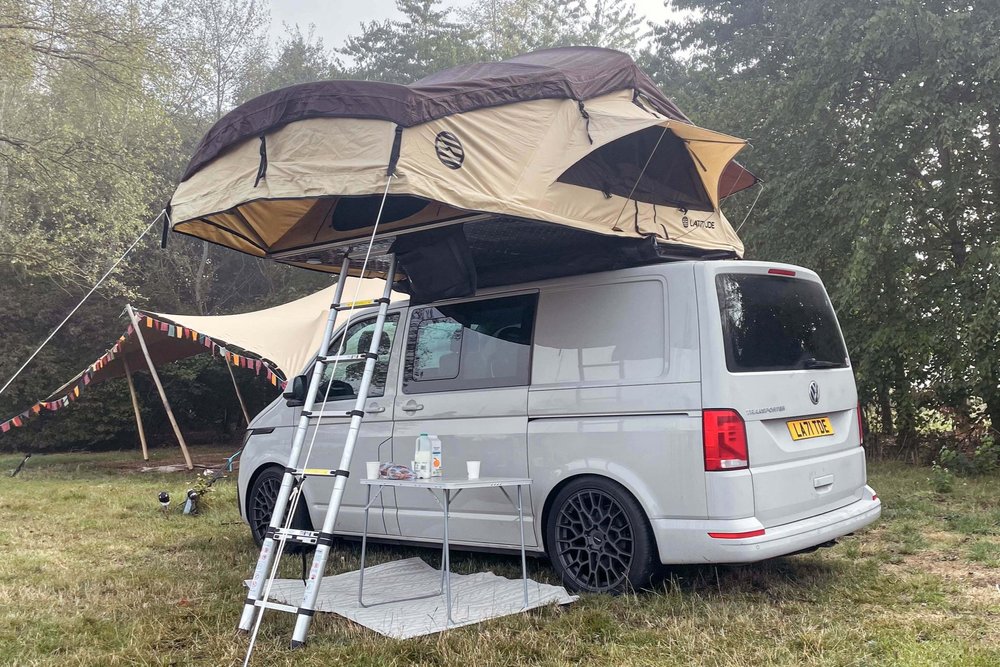

If you want a super affordable roof top tent for your family then the Latitude Pioneer XL is great choice.
High quality materials
Lightweight, breathable and rugged enough to tackle the harsh environment of woods and bad weather made with 280g Rip-stop Polyester Cotten and a waterproof and UV resistant coating
What we also love:
+ Skylight for stargazing - The Pioneer comes with skylights and multiple windows so you always have a great view wherever you look from inside the tent!
+ Travel Cover Material - 550g heavy-duty PVC cover to protect against the elements.
| Specifications | |
|---|---|
| Sleeping Capacity | 4 People |
| Setup Time | 5 minutes |
| Weight | 73 Kg |
| Sleeping Area | 190 x 310 x 130cm |
| Closed Dimensions | 190 x 125 x 25 cm (LxWxH) |
| Mattress | 6cm High Density Foam Mattress |
| Water Resistance | 600D Waterproof with UV + Mould resistance |
Pros
- 6cm High Density foam mattress
- Large space for comfort
- High-quality material
Cons
- On heavier side at 73kg (check your roof weight limits)
Best Roof tent for a Car

Tent & Trail Discover Series
Best Roof tent for a Car
Great Value Hybrid Roof Tent with Awning & lightweight at 48kg
Spaciously designed, its interior stretches an impressive 160cm by 236cm, surpassing even a King-sized bed's dimensions of 150cm x 200cm. This ample space ensures ultimate relaxation during your camping adventures, whether you're embarking solo or with friends and family.
Whether you're camping solo or with friends and a small family, the Tent & Trail Discover Series has great space and comfort on your adventure.
Aerodynamic Awning Extension included
A versatile feature for all weather conditions.
Need to escape the sun's blaze or find refuge from a sudden downpour? Crafted from the same robust Black 280g rip-stop polyester oxford cotton as the main tent. This material is not only UV resistant but also waterproof with a PU5000mm rating, ensuring durability and protection.

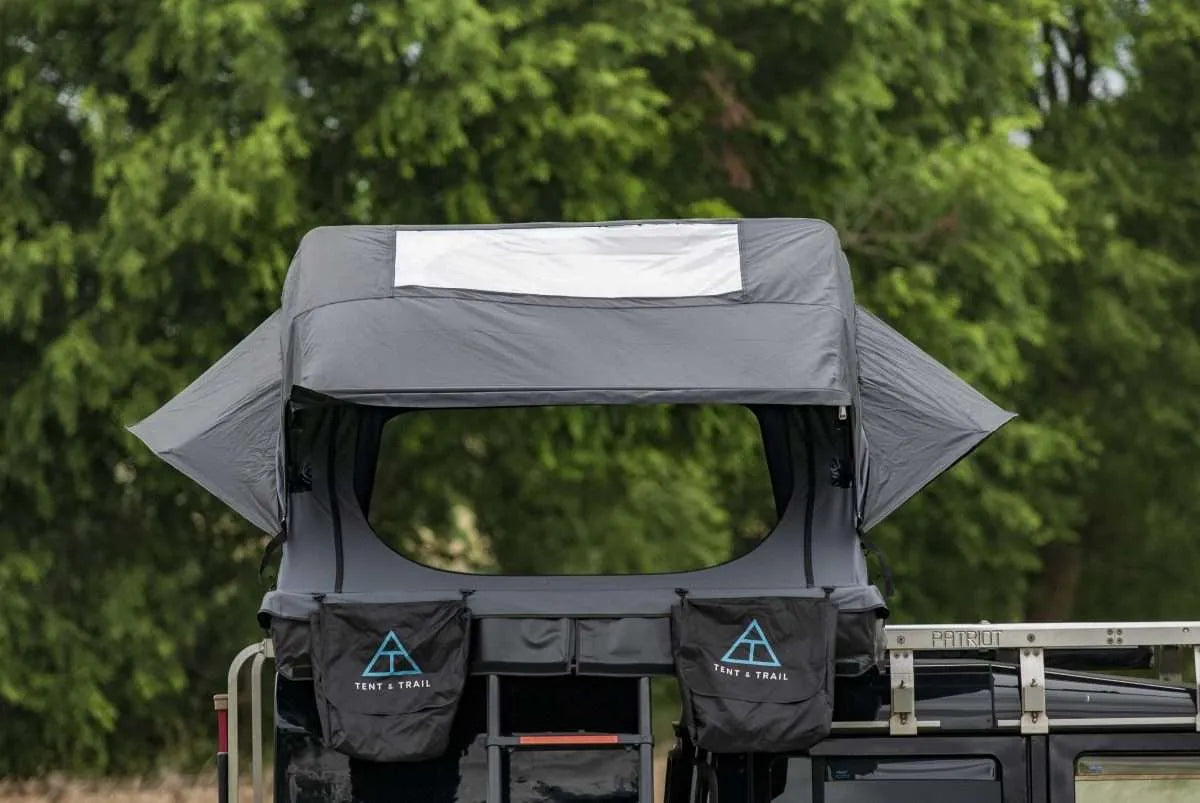

2 x Shoe Bags: Keep the inside of your tent pristine by storing muddy footwear in these handy bags.
Expansive Views: Featuring skylights and large windows, every angle inside the tent offers a stunning view of your natural surroundings.
Comfort for 2-3 People: With dimensions larger than a King-sized bed, the tent comfortably sleeps up to three, perfect for a small family or those who appreciate extra room.
Gear Load Capability: Heading on a sporty adventure? The Discover Series allows you to carry up to 35kg of equipment on top, be it a kayak, mountain bike, or extra luggage.
| Specifications | |
|---|---|
| Sleeping Capacity | 3 People |
| Setup Time | 5 minutes |
| Weight | 48 Kg |
| Sleeping Area | 236 x 160 x 155 cm (L x W x H) |
| Closed Dimensions | 160 × 117 × 26 cm |
| Mattress | 5cm High-density foam |
| Water Resistance | Waterproof with PU5000mm |
Pros
- Aerodynamic Awning included
- Large space for 3 people
- Hybrid hardshell for durability
Cons
- Set up time 5 mins
Best Rooftop Tent for 4x4s or SUVs

WildLand Bush Cruiser 140
Best Rooftop Tent for 4x4s or SUVs
A Hard-shell that is Super Sleek, Super Slim and Easy to Use
One of the thinnest rooftop tents you can buy on the market with the total height when closed topping out at 18cm so you won't have to worry about noise or drag whilst driving.
Comfortably Sleeps Two
Measuring in at 144cm x 206cm the Bush Cruiser 140 is bigger than a double bed (135cm x 190cm). Great for couples or if you just want some extra space
Luxurious Comfort with a 7cm Thick Mattress
Immerse yourself in a night of unparalleled relaxation with the WildLand Bush Cruiser 140 Roof Tent. Its luxurious rooftop design offers a lavish 7cm thick mattress, ensuring that every moment spent inside is a haven of utmost comfort.

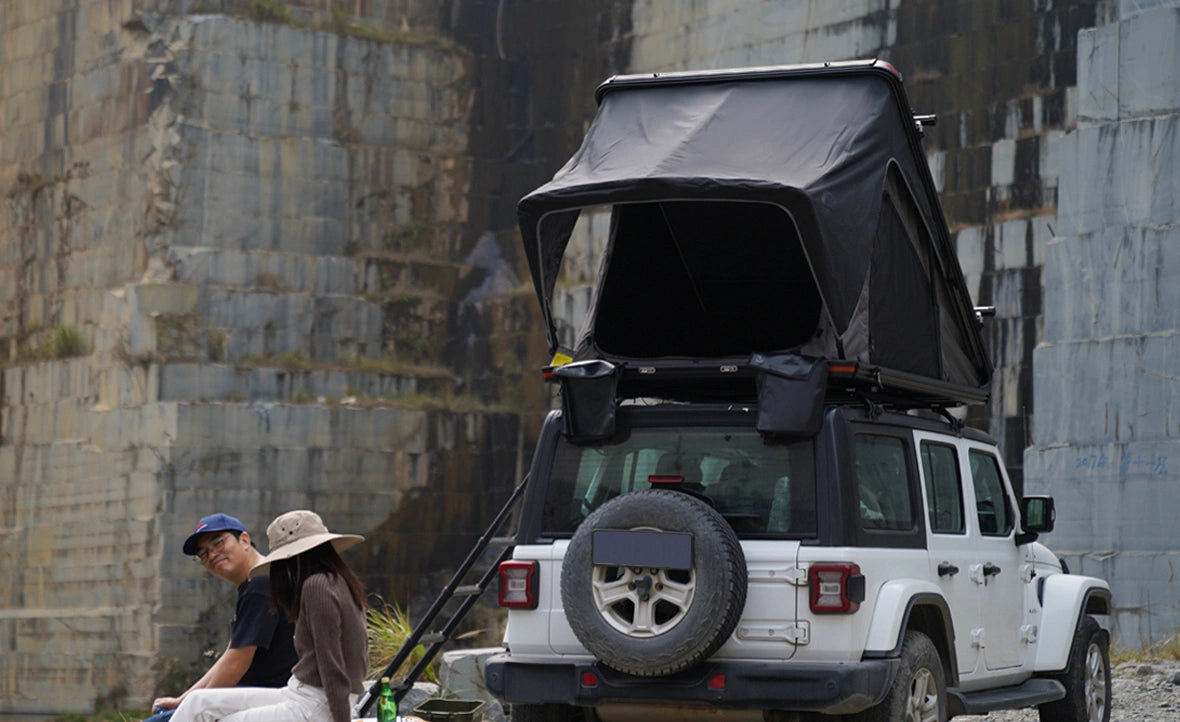

Quick and Easy Setup in Less Than 60 Seconds
Simply push up the top of the hardshell and the gas assisted struts will do the rest for you. Pull out some inner tent brackets and you're ready!
Large Windows for great views
Great large entry with two large windows on the side to give you awesome views to kick back in
What we love:
+ Super fast set up - Assemble your roof tent in under a minute
+ Comfy high-density mattress
+ Thin closed frame when driving
| Specifications | |
|---|---|
| Sleeping Capacity | 2 People |
| Setup Time | 30 seconds |
| Weight | 66kg (incl. Ladder) |
| Sleeping Area | 226 x 153 cm |
| Closed Dimensions | 226x153x18cm |
| Mattress | 7cm High-density Mattress |
| Water Resistance | Rip-stop Oxford PU coated 2000mm |
Pros
- 30s setup time
- Carry your gear on top
- 7cm High-density mattress
Cons
- Water resistance could be better
Our favourite lightweight Rooftop tent
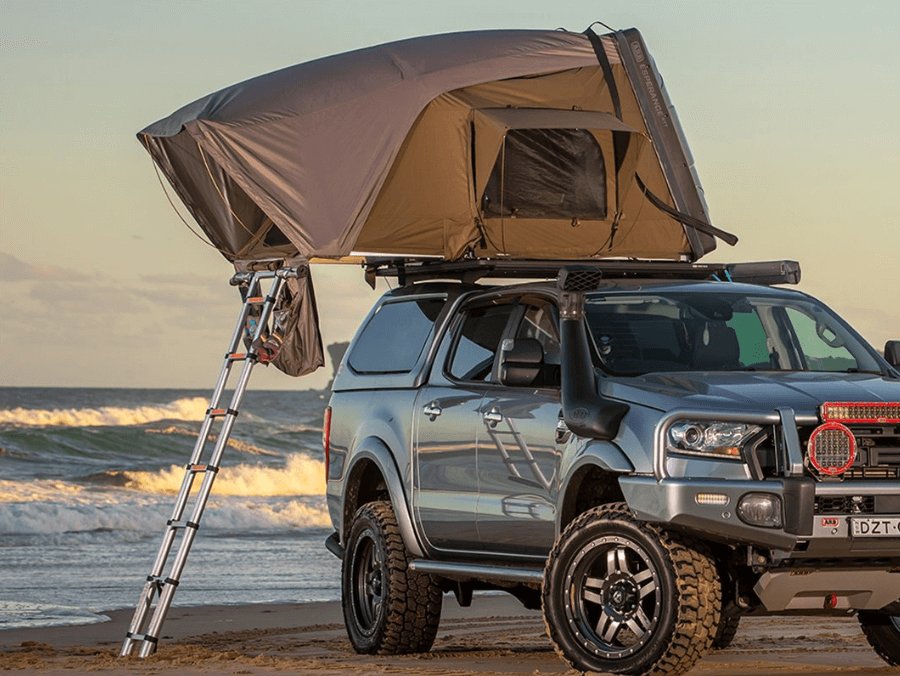
ARB Esperance Roof Tent
Lightweight Roof Tent with space
A Hard-shell roof tent that is lightweight and Easy to Use
Most rooftop tents are above 60kg in weight and can go as high as 90-100kg which can only really be used on 4x4s.
If you have a small car and you're worried about the weight limit on your car or even if you plan to carry more items on your car, then going for a lightweight rooftop tent is the way to go.
At 56kg this is the lightest hardshell roof tent on the market and perfect for almost every vehicle and great if you have a small car and want the benefits of hardshell roof tents.

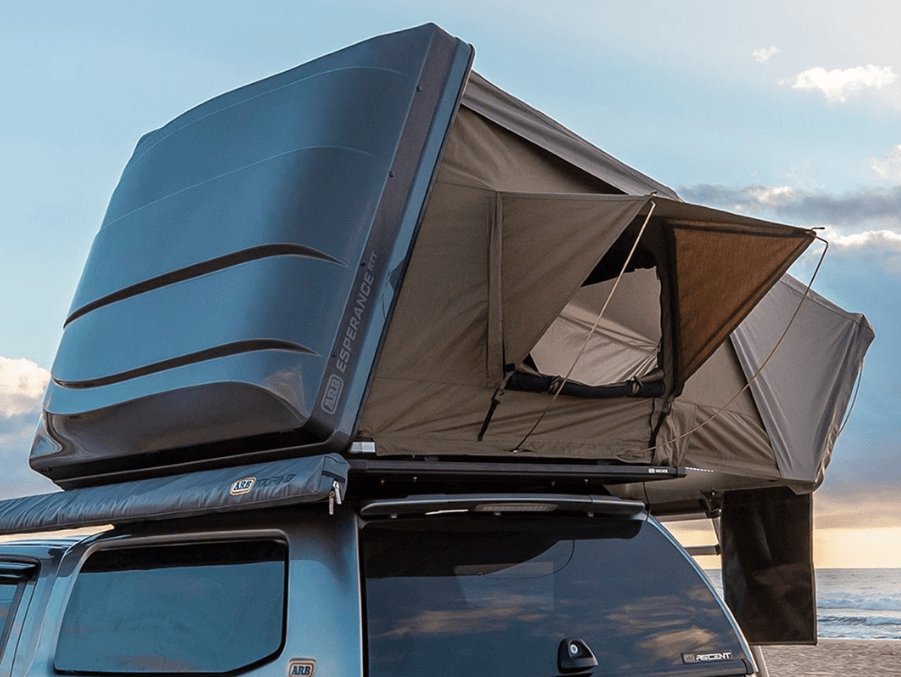
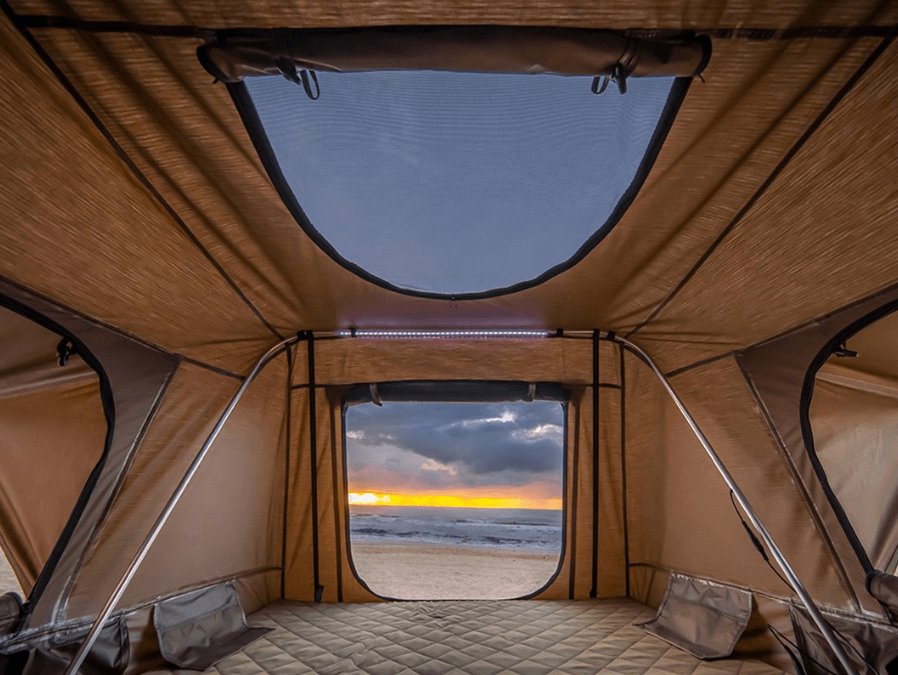
Large space for comfort.
There is great space in here for comfort and those who love rolling around in their sleep. A foam mattress measuring in at 1380mm (W) x 2000mm (L) is only slightly smaller than a queen size bed (which are usually 153cm by 203cm).
Robust Construction
Built with a combination of PU300mm, UV50+, PU+silver plating, and polycotton canvas resulting in an ultra-strong construction, that can withstand the harshest environments.
Internal Lights & USB Charging points
Features an LED touch lamp and 2 x USB charging points that can connect to a vehicle’s 12V outlet.
| Specifications | |
|---|---|
| Sleeping Capacity | 2 People |
| Setup Time | 2-3 mins |
| Weight | 56 Kg |
| Sleeping Area | 138 x 200 cm |
| Closed Dimensions | 150 x 123.5 x 30 cm (WxLxH) |
| Mattress | 4cm high density sponge Mattress |
| Water Resistance | 3000mm Hydrostatic Head Rating. |
Pros
- 2-3min setup time
- Large space for comfort
- Lightweight at 56kg
Cons
- Mattress comfort could be better
Rooftop Tent with the easiest set up

TentBox Cargo
Rooftop Tent with the easiest set up
Premium steel reinforced hardshell cover with a 30 second setup time
If you camp regularly then this will be a major factor.
The ease at which you can assemble and pack away your tent will make life so much easier when all you want to do is unwind for the evening especially if you've been hiking all day.
Simply put, there isn't another roof top tent that can open up in 30 seconds. Unbuckle the 2 latches, and push. The gas struts (made from marine grade stainless steel), will do the rest of the work for you.
The shell and frame is made out of steel reinforced honeycomb-aluminium panels with integrated ventilation at the base of the tent ensuring long-lasting durability with a design that keeps you cool in the summer months.


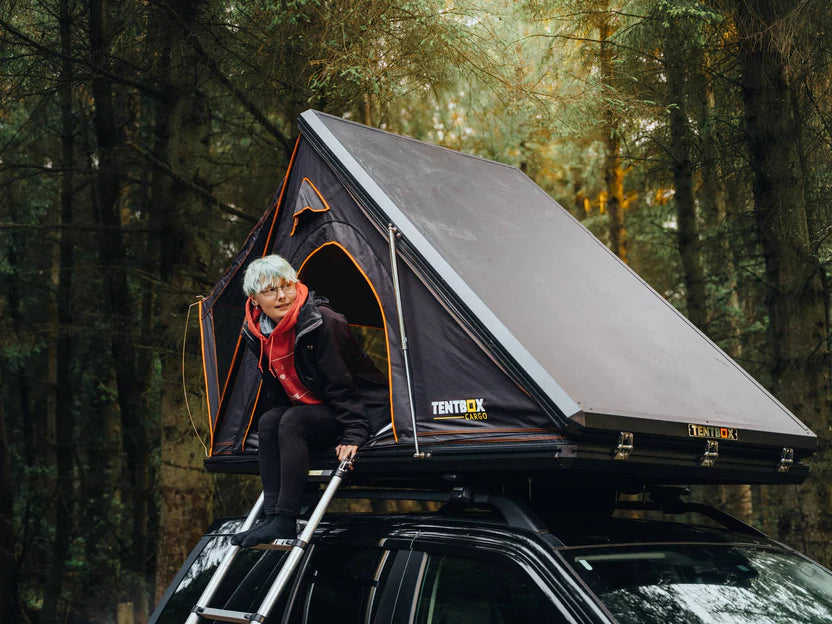
What's also awesome is that you can add additional roof bars on top which allows you to carry extra items or sports equipment on top! So if you're an active camper and want the convenience of packing up quickly and grabbing your mountain bike, then this is the one.
+ Great Wind resistance for the blustery UK weather! - Rated to last in winds of up to 39mph (which is a pretty heavy storm).
+ Carry your equipment on top - Save space in your car
+ The Rapid set up time - 30 second setup time. Yes, that's right.
+ Comfortable mattress - 6cm thick foam mattress for comfort and warmth.
| Specifications | |
|---|---|
| Sleeping Capacity | 2 People |
| Setup Time | 30 seconds |
| Weight | 74kg (excl. Ladder) |
| Sleeping Area | 125 x 210 cm |
| Closed Dimensions | 127 x 215 x 21 cm |
| Mattress | 6cm High-Density Foam Mattress |
| Water Resistance | 2000mm Hydrostatic Head Rating. |
Pros
- 30s setup time
- Keep your bedding inside
- Wind resistance up to 39mph
- Industry leading 5 Year Warranty
- Free Delivery
Cons
- Heavy so may not be suitable for cars
Best Premium Roof Tent Option

Femkes Khosi Family
Premium Roof Tent Option
Perfect for families and groups of friends.
With an internal mattress size of 180cm by 204cm the Femkes Khosi Family provides luxurious space. This is bigger than a Super King Sized bed (typically 180cm by 200cm).
The Femkes Khosi Family was designed to make sure comfort for you and your loved ones remains a top priority.
With a gas hinge opening mechanism to help assist you in the faster set up of your roof tent and high-density foam mattress and anti-condesation matt for a comfortable sleep you can keep your family happy.
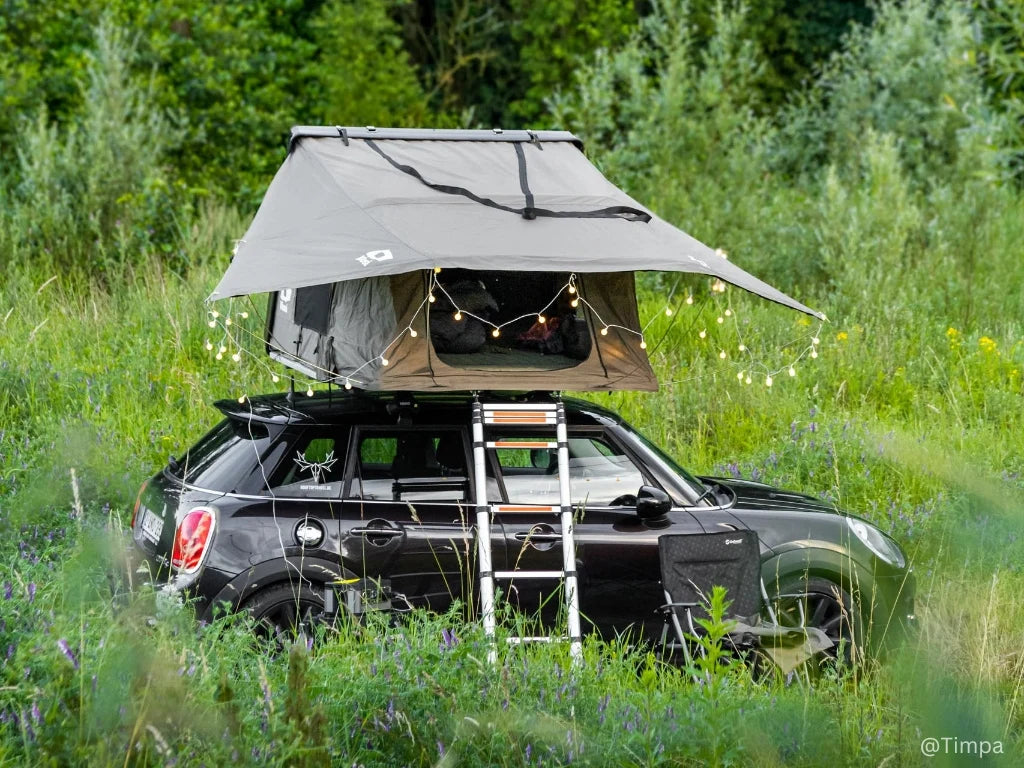
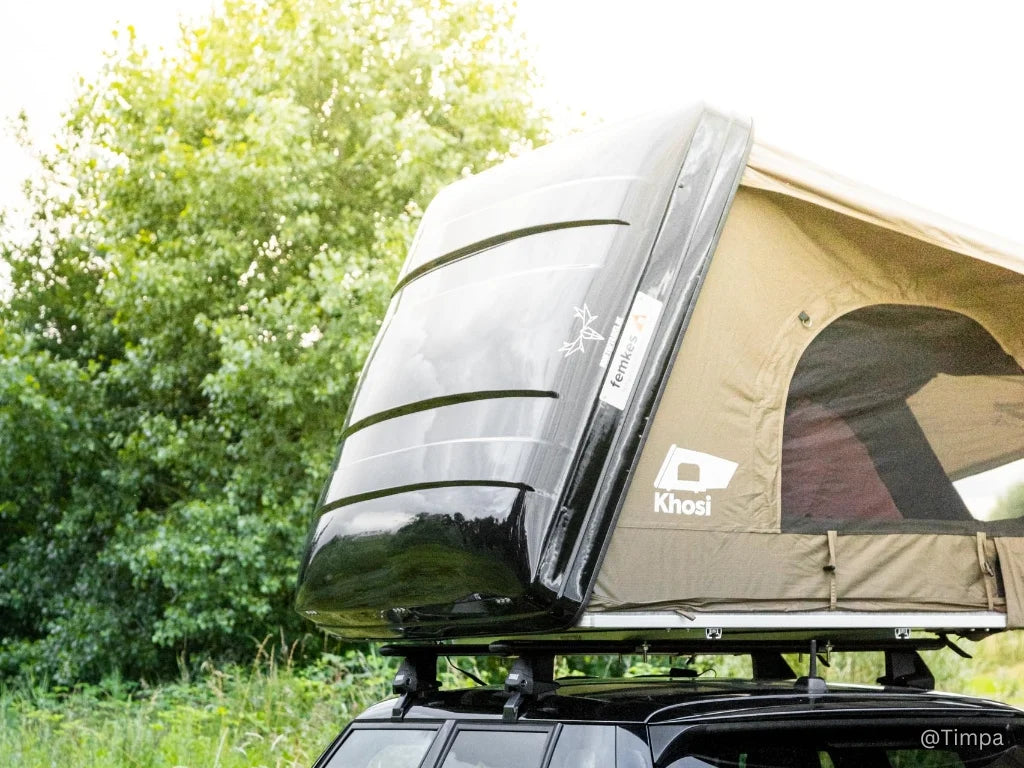
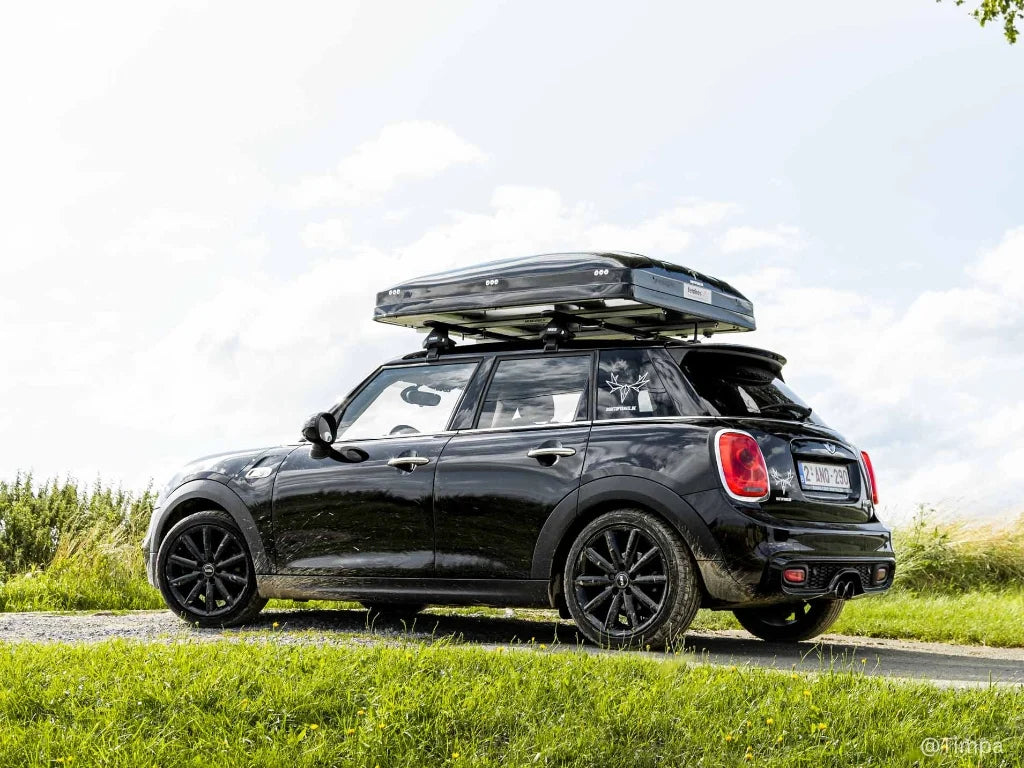
Free Zip-on Fly Tarp & Awning included
Set up the Fly Tarp and zip on the annex awning for extra cover. Both the Fly Tarp and Awning with 2 telescopic poles and guy ropes are included with the roof tent.
For extra protection from the rain the fly tarp has 3000mm HH rating. And UV 50+ sun protection.
ABS Shell for the hardshell cover
Using ABS plastic provides a great balance between impact resistance and not adding so much weight. It also provides very good chemical and heat resistance for long camping excursions during the summer.
Aluminium base plate
Chosen for its strength, durability, and resistance to corrosion. The foundation of the roof tent supporting the weight of your family.
| Specifications | |
|---|---|
| Sleeping Capacity | 4 People |
| Setup Time | 3-4 minutes |
| Weight | 70 Kg |
| Sleeping Area | 180 x 215 x 120cm (L x W x H) |
| Closed Dimensions | 190 x 140 x 33cm (L x W x H) |
| Mattress | 4cm thick Mattress + 1cm Anti-condensation matt |
| Water Resistance | 3000mm Hydrostatic Head Rating. |
Pros
- Free Zip-on Fly Tarp & Awning
- Great interior space
- Great rain & wind resistance
Cons
- Thinner High-Density Foam mattress at 4cm
Best Roof Tent with Awning
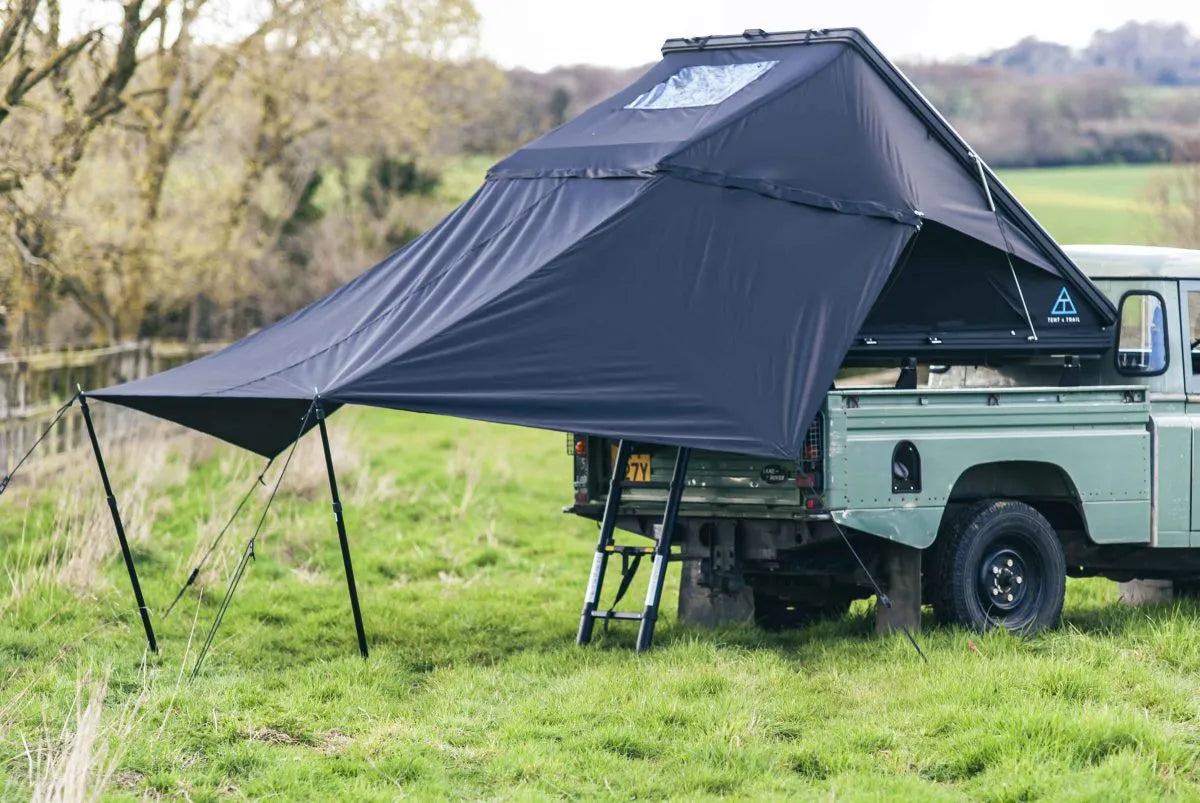
Tent & Trail Adventure Series
Best Rooftop Tent with Awning
Great value roof tent with awning with easy setup
The Tent & Trail Adventure series is perfect for those who want to get away and set up their camp space in minutes.
Awning extension with extendable poles, guy ropes, pegs and a hammer
With Tent & Trail just like all their other roof tents they want everything to come packed with value. With a zip-in awning, two shoe bags and a storage net under the tent base frame you will have everything you need to start your camping adventures.
Use the awning included for extra protection from the weather and use the area to set up camp. The awning has the same premium material as the roof tent with a Black 280g rip-stop polyester oxford cotton material equipped with UV resistant and waterproofing with PU5000mm.


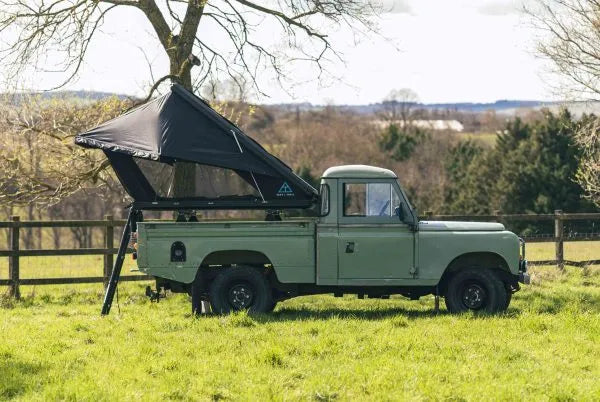
Designed with waterproofing all through out
The Adventure series has great water resistance due to the premium fabric material used throughout the design. With a Black 280g rip-stop polyester oxford cotton with waterproof rating of PU5000mm.
- High density foam mattress with a waterproof washable cover.
- Mattress bottom and sides with waterproof fabric
- Mattress top with poly-cotton fabric.
- Awning with Black 280g rip-stop polyester with PU5000mm
What we love:
+ Quick & easy set up - unclamp the cover, lift it up and fold out the tent via a pull with the telescopic ladder
+ Moon roof skylight - rare to see a skylight in a hard-shell roof tent
| Specifications | |
|---|---|
| Sleeping Capacity | 2 People |
| Setup Time | 1-2 mins (3-5mins with awning) |
| Weight | 76 Kg |
| Sleeping Area | 210 x 135 x 165 cm (L x W x H) |
| Closed Dimensions | 210 × 135 × 18 cm |
| Mattress | 6cm high density foam Mattress |
| Water Resistance | UV resistant - 5,000 HH Rating |
Pros
- Carry gear on top with roof bars
- Great space for 2 people
- Free Awning included
Cons
- Not suitable for more than 2 people
Best Roof Tent with Annex
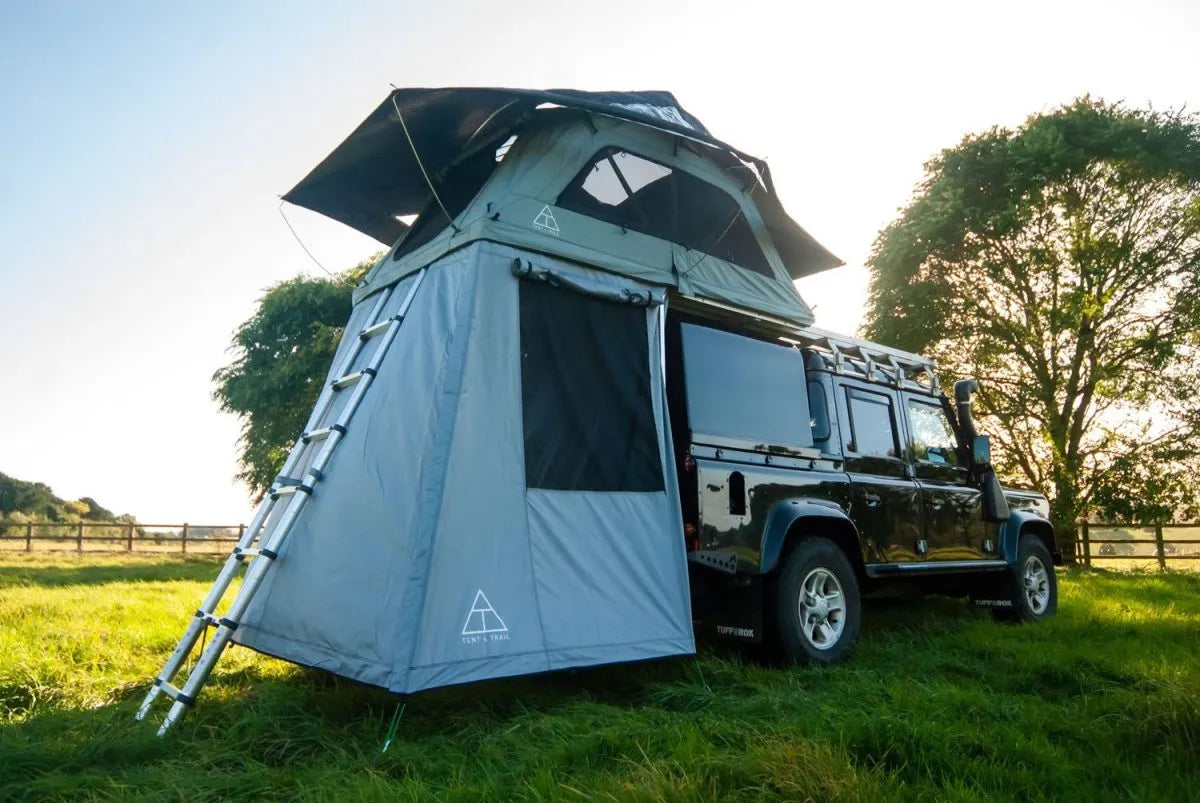
Tent & Trail Compact Series
Best Rooftop Tent with Annex
Great value roof tent with Annex
Rooftop tents are great for sleeping in, but they do lack the space and practicality to stand, get changed in or even take a quick shower.
If you're okay with changing up and showering at the campsite then you're all good. However, there are times where you will need to stop off and change or shower and you might be far away from the campsite.
Enter in, the Tent & Trail Compact Series... This rooftop tent is just packed with value. Great sleeping space for two people at 140cm x 240cm and the Annex Room which is a perfect private space included.

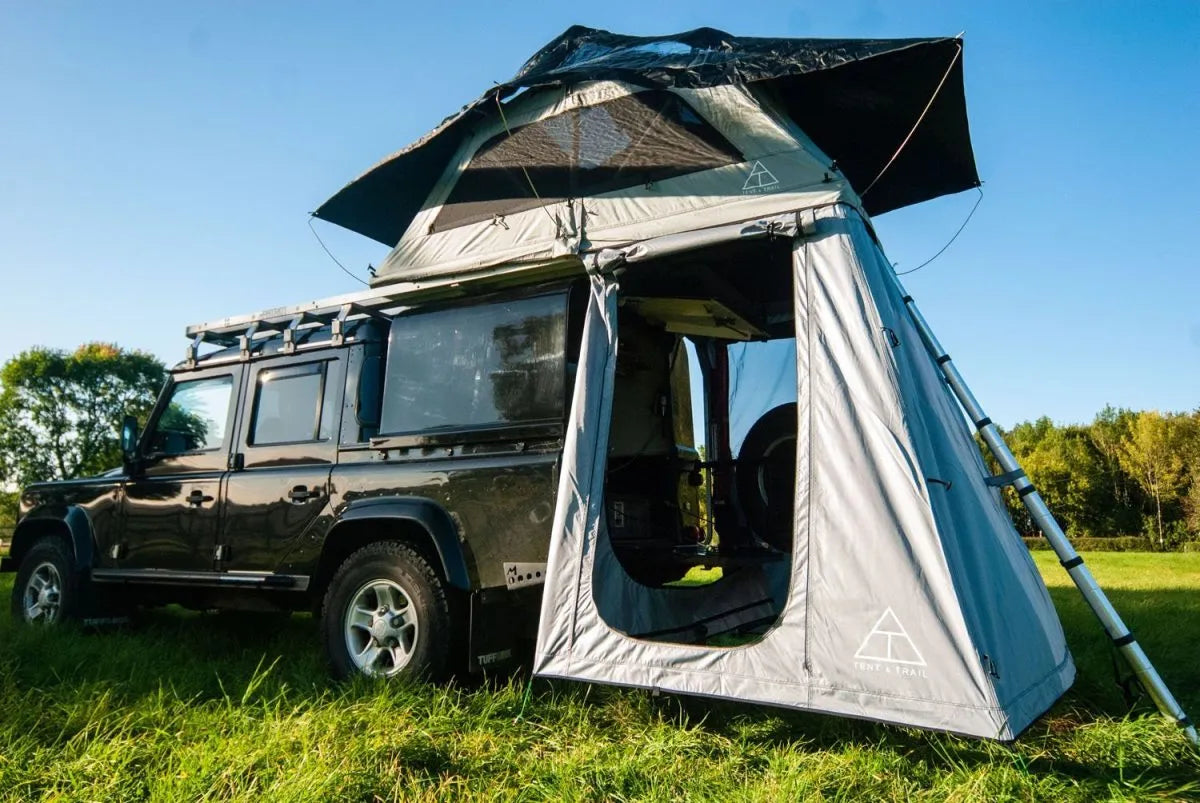

Made of high quality materials? Check. Great space for two people. Check. Simple no fuss set up time. Check. High-density foam mattress. Check. Comes with Annex? Massive Check.
What we love:
+ The Annex comes included
+ Great space for two people - 140cm x 240cm (Standard Double Bed is 138cm x 188cm)
+ Bedding can be stored inside when packed - Pack up and go fast!
+ 6.35cm high density bonded chip foam mattress
| Specifications | |
|---|---|
| Sleeping Capacity | 2-3 People |
| Setup Time | 5mins with awning |
| Weight | 55kg (65kg Overall) |
| Sleeping Area | 143 x 240 cm |
| Closed Dimensions | 140 × 120 × 30 cm |
| Mattress | 6cm high density foam Mattress |
| Water Resistance | 2500mm HH Rating |
Pros
- Annex Room Included
- Great space for 2 people
- Mattress waterproofing
Cons
- Lower HH Rating
RoofTop Tents Buyers Guide
Buying a rooftop tent is an investment that pays great dividends years into your purchase. But there are a few things to consider before purchasing one.
In the next few sections we've included an explanation for the most frequent questions we've been asked to help those who may be new to rooftop tents or would just like to know more.
What is a Roof top tent?
Yes, it's tempting just to say that a roof top tent is a tent that you stick on a roof. But there are so many bells & whistles that come a long with roof top tents that you wouldn't get on regular tents and thinking of them simply as that would do them injustice.
The awesome roof top tents we show later have different features that set them apart from each other, e.g. sleeping capacity, ease of set-up and weather resistance to name a few.
But yes... let's get the definition out of the way:
A Rooftop Tent is a Tent specifically designed to attach on top of the roof of your vehicle.
The key feature of roof tents is that you're elevated off the ground rather than a traditional ground tent. Not worrying about the wet ground is a huge relief.

Main Types:
Roof top Tents come in all shapes, sizes and materials. The two main types of Roof top Tents are Hard-shell or Soft-shell Rooftop Tents.
Hard-shell roof top tent
A hardshell rooftop tent is just a rooftop tent made of a hard exterior material.

Key features of a Hard-shell roof top tent
-
Made out of durable fiberglass, aluminium or hard plastic
-
Has a pop-up or clamshell opening design
-
Fast & easy assembly
-
More aerodynamic design when closed
-
Typically 4-season weather rated
Soft-shell roof top tent
Whereas a Soft-shell rooftop tent resembles a traditional ground tent and does not have hard exterior material.

Key features of a soft-shell roof top tent
-
Made from thick durable water resistant tent fabric
-
Are typically lightweight
-
Has a fold-out open design
-
Overhangs over the side of the vehicle with a ladder
-
Has great viewing angles with large front, back and side windows
-
Has a skylight window for looking at the stars
As we explain the 10 best roof top tents and why, take note of the different features that are most important to you. Maybe even list them in terms of importance to help you narrow down the right roof tent for you.
How do rooftop tents work?
What can you do with them?
By using a rooftop tent you can sleep on top of your car roof anywhere you're allowed to park your car. This will usually be at campsites or in a field if you have permission from the landowner.

You can be closer to the best hotspots with the amazing views, secure your sun bed at the beach or just travel further and more efficiently than being stuck at a hotel.
How do you assemble a roof tent?
So how do you set up your roof top tent once you've reached your destination? The two options are to fold-out or pop-up, both of which are much faster than traditional ground tents.
Pop-up
This is the easiest whereby you just unbuckle some latches and push open the top shell. Usually, gas-assisted struts will pop open the roof tent and it's all assembled!

Fold-out
Most common with soft-shell roof tents. Just pull off the travel cover, pull out the ladder and unfold the tent at a secure angle until it reaches the floor.

Getting in & out
You open and assemble your roof tent, typically within minutes, and climb into the tent through a large entry window with a ladder. Usually, they come with handy shoe bags for you to store your shoes away before you get into the main body of the tent.
How to Install a RoofTop tent
You will need to pick the correct roof top tent for your vehicles weight limit (which we will get into later) as well as the correct roof rack that fits your car. Additionally, your roof rack or roof bars needs to have the sufficient weight limit capacity for your roof top tent.
Installing a roof tent is slightly different for each make and brand and you should refer to the manual provided.
However, these are the following steps & tips:
-
Find a large clean workspace
-
Make sure all the components are included with your delivery
-
Ensure you have all the tools provided
-
Inspect your roof tent to make sure everything is in order
-
Have you and two other people help with lifting the roof tent on top of the roof rack.
-
Centre the roof tent so it is equally spaced out between the roof bars and across the car roof.
-
Make sure that the roof tent is not positioned more to the left or right of the vehicle.
-
Secure your roof top tent with the bolts and mounting brackets and make sure they are firmly screwed.
Are Roof Top Tents Worth it?

This question can only be answered by how frequently you plan to camp in the future.
If you regularly camp and want to travel far and wide with your car then we absolutely think a rooftop car tent is a no brainer.
Some other great benefits include:
-
Easy and quick set up times vs a traditional tent - No having to spend all that time pitching up a tent and nail in stakes which come undone.
-
They are more comfortable than regular ground tents - Better mattress comfort and the fact that you're going to be on flat surface by being your roof makes a world of difference.
-
You save a lot of money in the long run - What's most annoying is when you literally need a place to sleep to wake up early and go and you have to pay for a room you will barely use. The average cost of a hotel stay in the UK is £79 according to hotels-and-discounts.com. So just 7 nights at a hotel somewhere and you've paid out £553.
-
You're above the cold floor and away from the mud - Sleeping when the ground is wet is genuinely terrible and lets not get into the possibility of it raining and the tent flooding.
-
You're closer to the fantastic views by parking where you sleep! - Don't waste time having to drive to your planned destinations and get there faster before all the crowds.
-
Great space-saver - Save all the space you would have used for your tent and bedding inside your car.
-
Rain resistance - Rooftop tents come with great rain & water resistance typically with a Hydrostatic Rating of 3,000mm so don't need to worry about leaky tents!
-
Long lasting durable materials - Rooftop tents are generally made out of much more durable materials than regular tents, especially hardshell rooftop tents. Some are made of vehicle grade ABS with UV protective agent materials so that you can camp for years to come.
-
The Awesome View - When you wake up and see the view in the morning you'll get it. Elevated off the ground and being able to see the sky through skylight and looking left and right through the windows on a sunny morning just adds that bit of luxury.
Can they withstand the wind & rain?
Most roof top tents are 3-season rated meaning they are good for use for all seasons other than the winter. Some rooftop tents are 4-season rated meaning you can take them out all year round.
Wind
Most roof top tents can withstand 30+ mph winds. These are not ideal camping conditions anywhere but your roof tent will be able take blustery winds throughout the year.
For example, TentBox tents are tested up to 39mph which is a gale force wind.
Rain
Roof top tents are excellent at resisting rain and water as the materials they are made out of are water repellent fabric. They consist of the same materials as traditional ground tents if not better.
Take note of the Hydrostatic Rating, most come with 3,000mm of HH Rating. Meaning under testing conditions the column of water reached 3m before there was any leakage into the tent.
Hard-shell vs Soft-shell rooftop tents

Hard-shell rooftop tent Pros:
+ Usually faster & easier to set up
A well designed one can be assembled in 30 seconds compared to Soft-shell rooftop tents that typically take 5 minutes. Simply unbuckle some straps and push the top of the shell and the gas-assisted struts can do the rest of the work for you allowing you to get into bed faster or pack away to get hiking as soon as possible.
This is way better than removing the cover of a soft-shell roof tent, un-folding out the tent, maybe even attaching support poles and locking out all the inner support poles inside the tent. Additionally, most hard-shell rooftop tents don't have rain flys which also need to be set up in a soft-shell roof tent.
+ Can usually store mattress & gear in the tent when closed.
Most hard-shell rooftop tents have some space between the in-built mattress and the top shell which allows you to leave some light bedding and thin pillows. Super convenient if you want to get in and out quick on an activity based holiday or simply don't want the hassle of folding everything up every time.
+ More durable as they are made from tougher material
They are typically made from harder plastic to be able to take on the rough and tumble of camping. When you're camping you're bound to scuff your tent or have branches scrape and fall on it. Plus, not to mention that it rains a lot in the UK and this will slowly wear on your roof tent.
Some hard-shel roof tents include vehicle grade ABS or aluminium with UV protective agent materials which is super useful if you plan to camp all summer or leave your rooftop tent on top of your vehicle for long periods.
+ Store your gear on top
If you love a sporty or activity based camping trip then a hard-shell rooftop tent is your best bet. Soft-shell rooftop tents as of today do not have the capability to store and carry equipment on top of your rooftop tent.
Even if you want the added convenience of carrying extra luggage with you on your trip you can place this on top of your rooftop tent.
+ Attach Solar Panels on top
If you like getting techy and being able to go off-grid to power your electrical devices, lights and even a small refrigerator or cooler then you might like the challenge of installing a solar panel on top of your roof top tent. Even when the rooftop tent is open and you've wired everything correctly you can still charge your batteries with solar.
+ Four-season rated
Hard-shell roof top tents are typically designed to be used all year round. The hardshell is able to insulate warmth better than softshell tents giving you the flexibility to go camping during the winter months.
+ Are quieter with the wind
Because they are made of harder materials and typically have less plastic material and rain flys you'll get less of that annoying wind flapping that can happen literally all night. That can easily ruin an entire nights sleep if you are a light sleeper.
+ They feel more luxurious
Simply put, hardshell rooftop tents are made of more premium materials. Not only is the outer casing made of hard durable plastic with UV coating, but usually the walls are made from better fabric which may have some insulating fabric added to them.
+ They look cool
Feel free to disagree but hard-shell rooftop tents just have that sleekness about them that looks good up close and from afar. Not to mention the rooftop tents that have an aerodynamic design when closed with a bit of shine & gloss that just makes them look so pretty.
Hard-shell roof top tent Cons:
- Expensive due to the tougher and more durable materials
Hardshell rooftop tents are typically more expensive than soft-shell rooftop tents mainly due to greater design features and the higher quality or more durable materials used to make them.
- Heavier than soft-shell rooftop tents. Typically excess of 60kg
They are typically heavier than soft-shell rooftop tents which based on the type of vehicle you have and the dynamic weight limit of your car means you can only purchase a soft-shell roof top tent.
- Vehicle performance and handling is slightly worse than soft-shell rooftop tents being heavier and bulkier in nature.
Soft-shell roof top tent Pros

+ Usually more spacious as they fold out into a larger sleeping area.
Soft-shell roof top tents typically fold out so that half of the tent hangs over the side of the vehicle with a ladder that allows you to enter the tent. This enables a much greater sleeping space in comparison to hard-shell roof top tents with some being larger than a King sized bed.
Most softshell tents allow 2-3 people to sleep in or in some cases a 4 person capacity perfect for families or pet lovers. On top of that you can attach an annex or awning to the roof rack for an absolute luxurious camping space.
+ More affordable than hard-shell rooftop tents.
Soft-shell roof top tents are much more affordable with prices ranging on average at £1,000 to £1,500. In comparison, hardshell rooftop tents range from £1,500+ with some reaching the £3,000 mark.
+ Lighter in weight & more suitable for smaller cars.
Softshell tents tend to weigh between 45-60kg which makes them much more ideal for small vehicles and cars. This is due to the fact that smaller vehicles will have a lower dynamic weight limit (the weight you can carry on your car whilst in motion) than other large cars like SUVs or 4x4s.
+ Pack down smaller as they usually fold in half when closed.
Most soft-shell roof top tents have a fold out design which overhangs the side of the vehicle. That means when it is packed away it is folded and more compact. Because of this, it also makes them easier to manoeuvre when you install or pack away your roof top tent for the winter.
+ You can attach an annex or awning
Most soft shell roof top tents have an annex or awning designed to pair with the tent which gives you more private space when creating your own camping space.
An annex is a small tent that usually covers the ladder giving you privacy to change or even have a shower. An annex acts as a thin roof to protect you from the rain or the sun during peak hours of sunlight in the summer.
+ You can stargaze
Most soft shell roof top tents come equipped with a window through the top rainfly which is awesome for stargazing at night or waking up to see the sky on a stunning summer day.
Soft-shell rooftop tent Cons
- Are harder and more time consuming to set up and pack away.
Setting up and packing away takes longer and maybe frustrating the first couple of times you do it. After a bit of practice you should be able to assemble most roof tents in under five minutes.
- May not be able to leave your bedding or mattress inside when closed
The majority of soft-shell roof top tents do not allow for your bedding and pillows to be packed away with the tent. This is because most need to be folded and compressed when packed away.
- Won't be able to carry additional equipment on top
Soft-shell rooftop tents as of today do not have the capability to store and carry equipment on top of your rooftop tent.
- Are noisier
Due to the thinner materials and particularly the rainfly, strong winds throughout the night does have the tendency to create that really annoying flapping sound. Whereas with hard shell tents there are less rain flys and the outer shell is more robust in those windy nights.
- You may need two parking spaces
Since most softshell tents have a fold out design they will take up space adjacent to the vehicle which means requiring you to purchase two parking spaces at the campsite you visit.
How much weight can I put on my car?
Understanding your Car’s Weight Limits
Some cars offer enough space for all your baggage. But when passenger space is more important, you will have to consider the roof for all the travel gear.
For loading the gear without compromising road safety and risking vehicle damage, it is important to understand the weight limits of your car.
If you are using a car roof for camping, you need to know the static weight limit of your vehicle. But if you are travelling with luggage and weight on the roof, a dynamic weight limit instead will apply.
Static Weight Limit
The static weight rating is much higher than the dynamic weight limit.
Other frequently used terms for Static Weight Limit:
-
Gross Vehicle Weight Restriction
-
Gross Vehicle Weight Limit
-
Total Permissible Vehicle Weight
Dynamic Roof Weight Limit
Dynamic weight limit is the weight the roof of a vehicle can safely carry while moving.
When calculating the weight of the belongings to go on the roof, don’t forget to include the weight of the cross bars and racks.
Other frequently used terms for Dynamic Roof Weight Limit:
-
Roof Load
-
Dynamic Roof Capacity
-
Permissible Roof Load
-
Dynamic roof weight rating
Roof Rack and Rooftop Tent Weight Limits

When looking at how much weight a car can hold, it is important to note the weight ratings of the roof rack and the rooftop tents.
At first this can be tricky to understand but once you get it, you get it.
These are the main pieces of information you'll need:
-
The Dynamic Roof Weight Limit of your car
-
The Dynamic Weight Limit of your roof bars or roof rack
-
The weight of your roof bars or roof racks
-
The weight of your Rooftop Tent
-
The weight of any additional car roof items
-
The Static Weight Limit of the car
Using the above we are going check the following weight calculations:
Roof Bars
For your roof bars make sure the:
Rooftop Tent Weight + Additional car roof items
Dynamic Weight Limit of the Roof Rack
For your car roof load make sure the:
For your Static Weight Limit make sure the:


